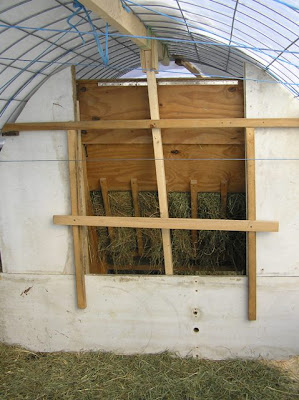The south end of a north facing goat house

We like stock panel structures. They help us house goats and chickens, dry and protect firewood. They provide a wind break and keep their contents dry. They are easy to erect and economical on a small scale. They are easily adapted for a variety uses. They allow us to provide for our animals needs with flexibility.
Pictured above is Goat House North. It has a goat house in each end with access to seperate paddocks. There is a human section in the middle where we store a week or two's worth of hay, minerals, etc. We can feed the goats from the human side and check on things. The goat house is made from six arched 4 X 16 stock panels sitting on top of some wooden side panels that give us an extra foot of headroom. the wooden sides are attached to posts. the posts help us keep the first two feet of stock panel vertical. For this year we also added pillars at the ends and a 2x4 ridge pole to insure against heavy snow. I have been successful in the past just using bailing twine cords to keep the arch in shape. But now that we have a total of 4 goat stall houses, a green house and a woodshed made from stock panels, I decided I didn't want to have to stress about keeping the roofs clear after snow storms.
We get between 20 and 40 degrees of temperatur difference from inside the goat house to the outside, depending on how sunny it is. That often makes the difference between frozen water bucks and not. It also keeps the animals comfortable on hard winter days and nights.













Labels: Cattle panel structure, chickens, CPS, Firewood, goat, Stock panel


5 Comments:
I'm looking at your goats' dining area, and am getting excited about something I think I see. Is the recessed manger with the two cross pieces effectively a waste-free hay feeder? Looks like you ask the goats to stick their necks across a small divide, creating two beneficial effects I would like to to emulate: 1) no climbing *into* the feeders; and 2) hay that is inadvertently pulled out while munching drops where it is not trampled! Ingenious! Why didn't I think of that? (Don't answer that.) ;-)
By Daddy Goat, at 1:55 AM
Daddy Goat, at 1:55 AM
Yup, that's a recessed, recycling non fouling feeder. The last picture on the post shows the opposite side of it. We load hay into the top. Goats are held outside by a breast bar. They reach in from their side, past the breast bar and into the crib to pull some out. What they drop falls onto a slope below and is kept outside their pen. They can still reach it when it falls. When we come out for milking or to freshen the water, 2 or three times a day, we fork the fallen hay back into the top. The recycler keeps them from stepping in it or mixing it with their bedding. In the morning, we remove any old hay from the day before and then fill with fresh hay. For four goats, we go through about 2-1/2 or 3 bales a week. The waste hay is set asside (where they can still pick at it through a hole). At the end of the month, the previous month's waste hay becomes the top bedding in a new goat house.
By MMP, at 12:21 PM
MMP, at 12:21 PM
Now you are just adding to my desire to move somewhere that I could replicate that! How wonderful and ingenious (to replicate what has already been said). Really enjoying your blog, thanks for making me aware of it today.
HDR
By Anonymous, at 8:58 AM
Anonymous, at 8:58 AM
PS. I take it these structures of yours are fairly mobile and easy to deconstruct here and reconstruct there? Do you have a post on that process, how it is done, how long it takes? If so, please point me to it. If not, it might be a good subject for a post!
cheers,
HDR
By Anonymous, at 9:00 AM
Anonymous, at 9:00 AM
MMP
You are the master of stock panel structures! :-D
WBF
By Anonymous, at 3:08 PM
Anonymous, at 3:08 PM
Post a Comment
<< Home